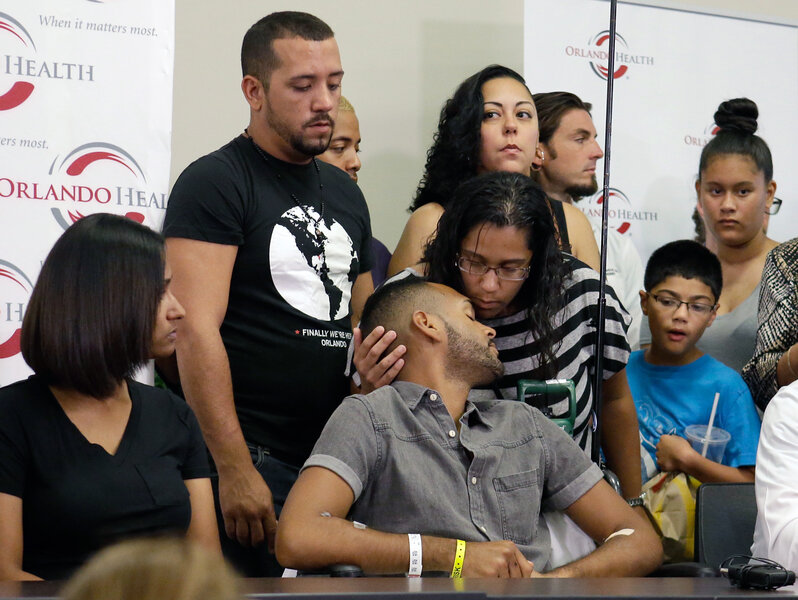Orlando attack: How to talk to kids about terrorism
Loading...
| Boston
As Americans struggle to make sense of the senseless violence in Orlando this weekend, parents and teachers face an added challenge: how to talk about it with young people.
However challenging it is, experts say that addressing the issue head-on – and looking for ways to help others – can help individuals overcome a feeling of dread and helplessness.
“Generally, students do not bring it up,” says Vicki Davis, a teacher at a private Christian school in Georgia. “But when you begin the conversation, it’s like opening a floodgate.”
It’s a question Americans are increasingly confronting. Attacks from Sandy Hook to Paris, magnified by a 24/7 news cycle, have caused violence and terrorism to loom larger in public thought. Adults, often overwhelmed themselves, either fail to notice how much it weighs on the minds of young people, or avoid the issue.
“Far too many teachers and parents ignore talking about it because they don’t know what to say,” says Ms. Davis, who writes an acclaimed blog helping teachers navigate a myriad of issues. “They often want to fix things or have an explanation, and when you’re dealing with senseless tragedy there is no explanation."
After the Paris terrorist attacks last fall, she had no idea one of her eighth graders had been at home crying and barely sleeping for three nights, “afraid terror was around every corner.”
The girl had seen the news and was worried about an upcoming class trip to Washington, which was on a heightened terror alert.
So Davis led a classroom discussion on the attacks, making sure the class had its facts straight and letting them know that the school officials would do everything possible to keep them safe. The girl’s mother called the teacher to say thank you – her daughter was happy and sleeping again.
“Knowing the signs of stress and how to help children cope increases our ability to help our children and teens navigate this horrific event,” says Dr. Robin Gurwitch, a clinical psychologist at Duke University who specializes in the impact of trauma and disaster on children, in a statement responding to the events in Orlando. “Starting the conversation is the first and most important step.”
A calm, reasonable approach
This doesn’t mean adults should sugarcoat news events, but a calm, reasonable approach goes a long way.
If a parent catches a child glued to a screen replaying horrendous images, for example, a gentle redirection of their attention can be better than frantically covering their eyes.
Specific tips differ depending on ages, according to Common Sense Media, a nonpartisan think tank that advises parents and policymakers on children’s media consumption.
For children under 7 years old, heavy parental censorship is recommended to keep young, impressionable minds free of graphic images. If a child is playing out a disastrous scenario, say with Legos, a parent could help guide them to finish their game by coming up with solutions that involved helping fellow Lego citizens and preventing future events – such as stationing T-Rex on the outskirts of town.
For kids between 8 and 12, parents should have limited discussions and be available for questions based on their own intuition about the child’s sensitivity and maturity level. In some instances adults may talk about their own sadness regarding an event, while reassuring children that they will be OK.
Once young people move into adolescence and young adulthood, students may pick up more than the adults around them through social media so the recommendation is to check in regularly and discuss what they’ve learned – and also talk through which news sources are most reliable.
Separating facts from fiction
Davis worries that children who don’t have a conversation that separates facts from fiction about such events could produce a generation of adults who are too easily moved to hatred by a sensational news cycle.
Davis recounts one instance where a student told her everyone should be afraid of UPS drivers because she had heard something in the media about terrorists having stolen a bunch of UPS uniforms. Davis was able to find the story online and bring it up on a projector screen in her classroom, and use the website Snopes to fact-check the story and prove it was false.
But not every teacher has the flexibility Davis does to discuss events. The capacity of schools to have these conversations varies by district across the nation – some ban such events being discussed in the classroom, while others think the school plays an integral role.
Melissa Brymer, director of terrorism and disaster programs at the UCLA–Duke National Center for Child Traumatic Stress, says she’s seen “powerful change” as a result of after-school groups discussing terrorist or mass-shooting events, with a teacher acting as advisor or moderator.
Such measures are effective at the college level as well.
At UCLA, Ms. Brymer says students convened groups with the help of staff and planned activities for a campus event highlighting their desire for measures to prevent gun violence in the wake of June’s murder-suicide, in which a former student killed a professor.
“Sometimes, many times adolescents want to find a way to give back. It can really help with healing, to do things with others – to be part of the solutions,” she says.








